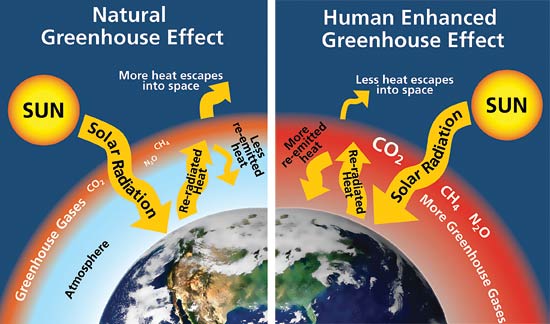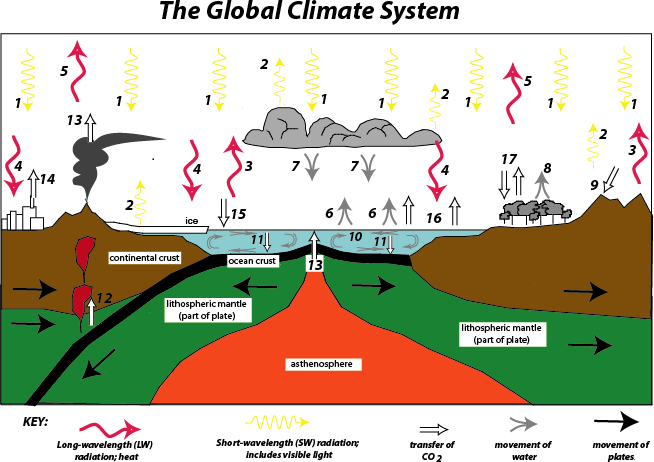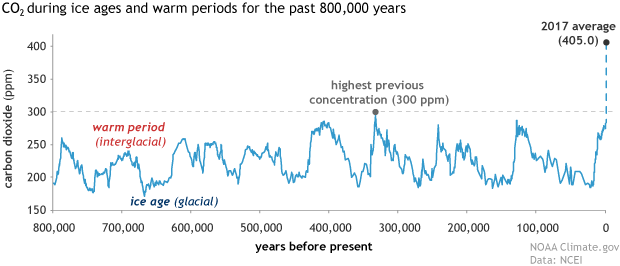The greenhouse effect is a natural and necessary part of the climate system. Without it, the average surface temperature, which is about 59 °F (15 °C), would be about 0 °F (-18 °C), drastically changing life, as we know it, on Earth. The problem today is that human activities are amplifying the natural greenhouse effect. And in this case, too much of a good thing is the opposite of great.
The greenhouse effect works because solar radiation (i.e., sunlight) passes through the atmosphere relatively unobstructed. The atmosphere, clouds, and surface reflect some of that sunlight; atmospheric particles scatter a small portion of it back to space, and the atmosphere and clouds absorb another fraction. Still, about half of the sunlight reaches Earth’s surface. After absorbing the sunlight, the surface warms and reradiates longer wavelengths of light. A small proportion of this longwave radiation passes unimpeded through the atmosphere into space, but the greenhouse gases (GHGs) – which allow sunlight to pass but not the longer wavelengths of light – absorb most of it, effectively trapping this energy in the lower few miles of the atmosphere and raising the temperature of this layer. As noted, this natural process raises Earth’s surface temperature to levels needed to sustain life. The balance is delicate, and increases in the atmospheric concentrations of the GHGs trap more outgoing longwave radiation and result in rises in air temperature.

Because the climate system is a complex interconnection of the atmosphere and the various subsystems that make up the surface (that is, the soil and rock, ocean, vegetation, and ice cover), heating of the atmosphere’s lower few miles results in changes that propagate throughout the climate system. The ocean also warms, raising sea levels and releasing water vapor through evaporation. The continental surface warms, causing even more evaporation. The additional atmospheric water vapor results in more precipitation, although the distribution is uneven and some places get wetter while others get much drier. Sea ice, permafrost, seasonal snow cover, and glaciers melt under these warmer conditions, with glacier melt further raising sea levels; losing these bright, white surfaces reduces surface reflection and increases the absorption of incoming sunlight, further raising temperatures. There are many, many more changes that take place, but the point is that increasing the greenhouse effect means that the entire climate system must adjust to compensate; hence, scientists prefer the term “climate change” instead of the more popular “global warming.”

Basics of the global climate system showing the flows of energy, water, and CO₂ that are important in controlling the climate. Solar energy drives the global climate, but clouds, plants, volcanoes, ice, and the oceans all play important roles in regulating the Earth’s greenhouse and determining what happens to solar energy. CO₂ and water are the principal greenhouse gases that absorb heat emitted from the surface and then re-radiate the heat back to the surface; this process maintains the Earth’s temperature at a comfortable level. The numbers in this figure refer to the following key.
- Incoming short-wavelength solar radiation
- Reflected short-wavelength solar radiation
- Emission of long-wavelength radiation (heat) from surface
- Absorption of heat by greenhouse gases and emission of heat from the atmosphere back to surface (the greenhouse effect)
- Emission of surface heat not absorbed by the atmosphere
- Evaporation cools the surface, adds water to the atmosphere
- Condensation of water vapor releases heat to the atmosphere, precipitation returns water to the surface
- Evapotranspiration by plants cools the surface
- Chemical weathering of rocks consumes atmospheric CO₂
- Oceans store and transfer thermal energy
- Sedimentation of organic material and CaCO3 transfers carbon to sediment on the ocean floor
- Melting and metamorphism of sediments sends carbon back to surface
- Emission of CO₂ from volcanoes
- Emission of CO₂ from burning fossil fuels
- Cold oceans absorb atmospheric CO₂
- Warm oceans release CO₂ to the atmosphere
- Photosynthesis and respiration of plants and soil exchange CO₂ between atmosphere and biosphere

- yes, CO2 concentrations have fluctuated over time
- the current concentrations are much higher than anything in the geologic record
